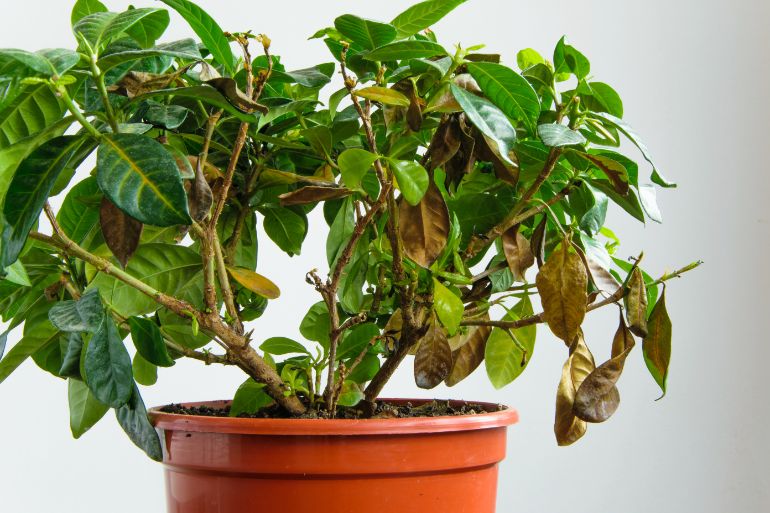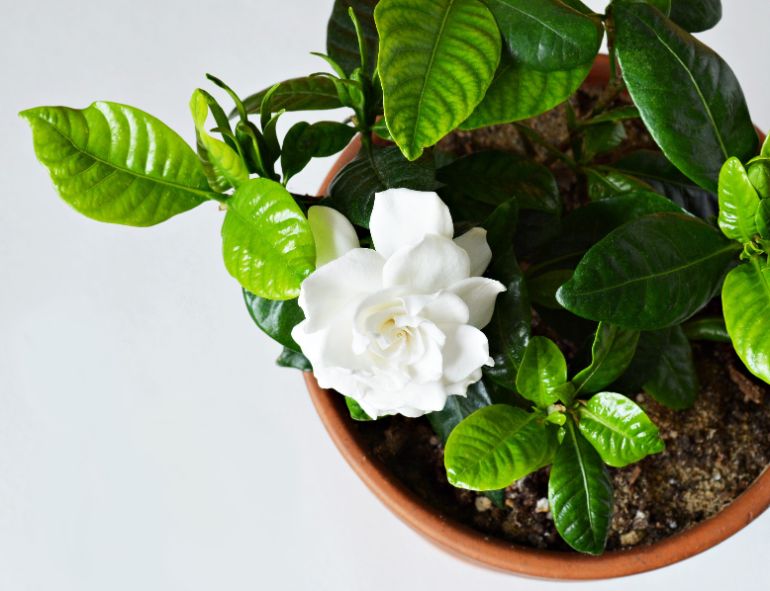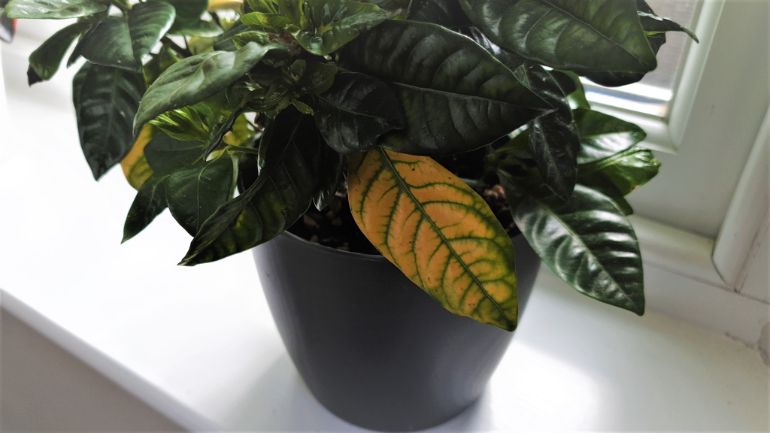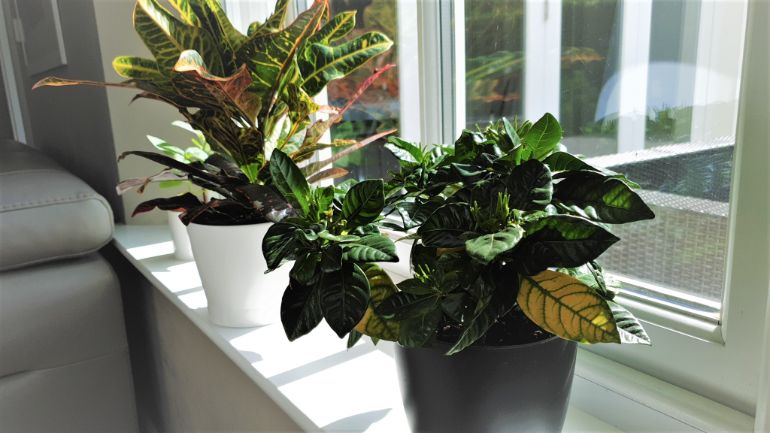The fragrant blooms and glossy green leaves of Gardenias make them a delight to grow indoors or outside. The only problem is they can be tricky to keep happy, so you need to work hard to enjoy them at their best. If you’ve found your Gardenia dying or looking a little unhealthy, this article will help you work out what the problem is, and get your plant thriving again.
The most common cause of a Gardenia dying is root rot caused by soggy soil conditions or overwatering. Look for generalized leaf yellowing and wilting despite wet soil. Pests, disease, insufficient light, and overfertilizing are also common causes of a Gardenia struggling.
Signs Of An Overwatered Gardenia (Gardenia Jasminoides)
The most common reason for a Gardenia dying is overwatering, so this should be the first thing you check for. More specifically, any issue that causes your plant to sit in soggy soil for a prolonged period of time increases the risk of root rot, which is often fatal for an affected plant.
Here are the things to look for that may indicate an overwatered Gardenia;
- Generalized leaf yellowing, often starting with lower, older leaves first.
- Widespread leaf drop, despite the soil being damp.
- Brown leaf tips, particularly affecting new growth.
- Bud drop despite adequate light, temperatures, and water.
- Sudden wilting of your plant.
If your plant fits this description, the next thing to do is to identify why it has happened.
Overwatering has more to do with a lack of root aeration than an abundance of water. It’s just that soggy soil conditions prevent air circulation within the soil, depriving the roots of oxygen for respiration.
Without a steady supply of oxygen, the roots become stressed and weakened, dying, or succumbing to opportunistic pathogens that cause root rot.
How To Fix A Gardenia Dying Due To Overwatering
The solution to overwatering problems depends on what factors are causing the soil to stay soggy for longer than it should.
Check the following things to see if any are contributing to poor soil aeration;
- Watering on a schedule – Always check to make sure the top inch or so of soil feels dry before watering. Adding water without checking if your plant needs it almost always leads to problems. Gardenias do best when their soil dries out a little before watering. Read my tips for watering houseplants here.
- Not draining the pot fully after watering – Remember to empty any drip tray or cachepot a few minutes after watering so the roots aren’t sitting in water.
- Make sure the pot you use has plenty of drainage holes – A lack of drainage holes will cause water to pool at the bottom of the pot after watering, greatly increasing the risk of root rot.
- Using a pot that is too large – A small plant in a large pot will take a long time to use the available water in the soil after watering. Repot your Gardenia into a pot that is just large enough for the plant.
- Low light conditions – Gardenias ideally need 8 hours of full sun per day to stay healthy. Make sure to place your plant on a sunny windowsill if growing inside. Your Gardenia will use less water in lower light conditions, and the soil will dry out more slowly, increasing the risk of overwatering problems.
- Pot Material – Non-porous pot materials such as plastic or metal hold water in the soil for longer, increasing the time it takes the soil to dry out. Switching to a terracotta pot will help the soil dry faster.
Gardenia Root Rot
If you find your Gardenia dying and you think soggy soil has been the main culprit, it is a good idea to check for any signs of root rot before going any further. Once root rot has set in, it is a race against time to save your plant, as this problem will only get worse and lead to your plant dying if not treated.
Here are the steps to take to check for and treat root rot in Gardenias;
- Gently slide your Gardenia out of its pot and inspect the roots for any signs of rot. Rotten roots will be brown/black, fragile, mushy, and will likely have an offensive odor. Gently remove excess soil from around the roots to observe the extent of the problem.
- Use sterile pruning shears to remove all affected roots. If less than half the roots are affected, there is a chance you can save your plant. If more than half of the roots are affected, it would probably be better to dispose of the plant and start again.
- Once all the affected roots have been pruned off, gently remove the remaining soil from around the roots. Take your time and go gently to avoid damaging the healthy roots. Rinse the remaining soil off with water, so the roots are completely exposed. Removing the old soil is important as it will contain the same pathogens that were causing the root rot.
- Choose a clean pot and repot your Gardenia using fresh, well-draining potting mix.
- Water lightly. Make sure to drain off as much of the excess water as possible.
- Maximize humidity, and place in bright, indirect light for a few weeks. The roots of the repotted plant will be in a state of shock, and will likely take a while to recover. It is important to minimize water loss during this time.
Hopefully, your Gardenia should start producing new growth after 6-8 weeks. The success rate of treating root rot is far below 100%, so there is no guarantee your plant will recover. This process gives it the best chance.

Why Is My Gardenia Dropping Leaves?
Leaf drop is another common issue with Gardenias, and will often continue without a break until the cause of the problem is corrected. The issue with leaf drop is that there are many causes, so you have to do a little detective work to identify the problem.
- Chronic or repeated underwatering can result in leaf drop. This usually affects lower, older foliage first.
- Soggy soil conditions can also cause leaf drop. Look for other symptoms of overwatering to give you clues about the cause. Read more about telling the difference between an overwatered and underwatered plant here.
- Alkaline soil will cause leaf chlorosis, followed by leaf drop. It’s common to mistake this for an overwatering issue. Gardenias prefer a soil pH of 5-6, and a pH over 7 can lead to significant issues. Check soil pH if in any doubt.
- Gardenias can sometimes drop leaves due to acclimation. As the plant adapts to your growing conditions and recovers from the stress of the journey to your home, it may experience some leaf drop. This should stop after a few weeks as long as you are providing good care conditions. If it continues, look for other causes.
- Drafts and low humidity can also cause Gardenias to drop leaves, so make sure you don’t have your plant positioned near drafty windows or heating appliances. Try to keep humidity levels above 50% to prevent leaf drop issues.
Insufficient Light
Low lighting is one of the most common causes of problems when growing Gardenias, resulting in weak growth and lack of blooms initially, but often resulting in a Gardenia dying eventually.
Gardenias have extremely high light requirements, needing at least 8 hours of strong sunshine per day to remain healthy and growing at their best. This is usually a bigger issue inside, where light intensity is always much lower than outside.
The light intensity on a sunny windowsill can be up to 50% less intense than direct sunlight outside, and light intensity drops rapidly as you move your plant away from the window. You can read more about light requirements for indoor plants here.
If your Gardenia is struggling, and it is positioned anywhere except on the sunniest windowsill in your home, move it to a brighter location. It’s not the solution to all problems, but is essential to keep a Gardenia healthy.
Overfertilizing
Whilst everyone wants their Gardenias to grow quickly and look beautiful, fertilizing too much always causes more harm than good. Plants get most of their energy from the sun, through the process of photosynthesis, so they only need small amounts of nutrients from the soil.
Adding a little nutrition to the soil helps to prevent nutrient deficiency, but adding more than your plant needs can damage the roots, and in turn the rest of the plant. Look for the following signs that you are overfertilizing your Gardenia;
- Brown leaf tips and edges
- Brown patches on the leaves
- White fertilizer crusts on the soil surface
- Generalized leaf drop
- Bud drop, or lack of blooms
If you think overfertilizing could be the cause of your Gardenia dying you should flush the soil with copious quantities of water to try to dissolve and flush out excess minerals from the soil. Alternatively, you could repot your plant in fresh potting mix.
Avoid fertilizing again for at least 6 months, and then resume a more conservative fertilizing regime. I like to fertilize my Gardenias every four weeks during the growing season with a water-soluble fertilizer for acid-loving (ericaceous) plants. You can read more about the options for fertilizing houseplants here.

Gardenia Pests
Gardenias don’t tend to be excessively prone to pests, but a significant pest infestation can result in your Gardenia dying, so it’s good practice to check your plant regularly for signs of problems. Aphids, mealybugs, whitefly, and spider mites are the most common culprits you’ll find.
I usually check my plant every time I water it for signs of pests. Remember to check on both sides of the leaves, as well as along the stems and in the soil for any signs of pests.
Whilst some pests will eat the leaves, many, such as aphids and spider mites pierce the leaves to suck the juices from your plant. This usually results in small yellow dots all over the leaves in an irregular pattern. Look for both the pests themselves, as well as evidence of pest damage.
If you think your Gardenia has been affected by pests, isolate your plant immediately from any other plants to prevent the problem from spreading.
I usually like to manually remove as many of the pests as possible, either with a cloth or by rinsing the plant with a stream of water. I then spray the plant and soil thoroughly with either horticultural oil, insecticidal soap, or isopropyl alcohol. All three options tend to be equally effective but usually require repeat treatment.
Repeat the treatment process every 5-7 days for a few weeks until you are 100% sure all the pests have been dealt with. You can remove your plant from isolation once you are confident the pests are gone.
Gardenia Diseases
The most significant disease that can result in your Gardenia dying is root rot. This is typically caused by phytophthora, rhizoctonia, or pythium, which all thrive in the anaerobic conditions of soggy soil. Prevention is the best option because severe root rot can easily kill your plant.
There are a few other less serious diseases that can affect your Gardenia;
- Stem canker caused by Phomopsis gardeniae – This typically causes dark brown stem lesions that can cause wilting, leaf yellowing, and bud drop on the affected branches.
- Sooty mold – This is a highly visible black fungal infection that covers the leaves. It is usually caused when fungi grow on the honeydew that a number of pests secrete on the leaves after feeding. Sooty mold can be wiped off the leaves. It doesn’t damage the plant but is a warning sign that you have a pest problem to deal with.
- Powdery mildew – This is a white/gray powdery fungal growth that causes leaf yellowing, leaf drop, and deformed leaves and buds. It is more likely in warm, moist, humid, poorly ventilated conditions.
Why Are My Gardenia Leaves Turning Yellow?
Yellowing leaves is often due to overwatering, causing generalized leaf yellowing, affecting the lower leaves first. Pests will often cause yellow spotting on the leaves, and iron deficiency, often due to elevated soil pH will cause leaf yellowing that spares the leaf veins.
Leaf yellowing is one of the most common Gardenia problems, and should always prompt careful inspection of your plant. You will need to consider both the care conditions as well as the symptoms your plant is showing to work out the cause.

Why Are My Gardenia Leaves Curling Up?
Gardenia leaves curling is a sign that the leaves are either not getting enough water or are losing water too quickly. Underwatering is a common cause, but root rot will also cause curling leaves. Low humidity and excess heat can also result in Gardenia leaves curling.
Why Is My Gardenia Wilting?
The most common causes of a Gardenia wilting are underwatering, or root rot due to excessively soggy soil conditions. Diseases, pests, low humidity, transplant shock, or hot conditions can also cause wilting. It is essential to look at all the plant symptoms and consider the care condition to help identify the cause.
Last Word
Gardenias can be tricky to keep healthy, and there are many problems that can result in a Gardenia dying. Despite this, their beautiful, fragrant flowers and delightful foliage are worth every bit of effort required to keep them healthy.
If you’d like to learn more about houseplant care or have other problems looking after your houseplants, check out some of my other articles listed below. Alternatively, check out my book, “Houseplants Made Easy“, which covers everything you need to know to grow beautiful houseplants, that thrive year after year.

